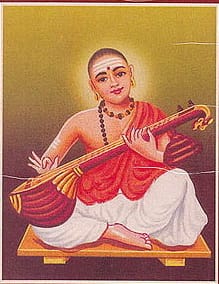Muthuswami Dikshitar ( 24 March 1776 – 21 October 1835
Muthuswami Dikshitar ( 24 March 1776 – 21 October 1835), Dikshitar was a South Indian poet, singer, and veena player, and a legendary composer of Indian classical music, who is considered one of the musical trinity of Carnatic music.
Muthuswami Dikshitar was born in Tiruvarur near Thanjavur, in what is now the state of Tamil Nadu in India, to a family that is traditionally traced back to Virinichipuram in the northern boundaries of the state. His compositions, of which around 500 are commonly known, are noted for their elaborate and poetic descriptions of Hindu gods and temples and for capturing the essence of the raga forms through the vainika (veena) style that emphasizesgamakas.
They are typically in a slower speed (chowka kala). He is also known by his signature name of Guruguha which is also his mudra (and can be found in each of his songs). His compositions are widely sung and played in classical concerts of Carnatic music.
The musical trinity consists of Dikshitar, Tyagaraja (1767–1847), and Syama Sastri (1762–1827). However, unlike the Telugu compositions of the others, his compositions are predominantly in Sanskrit. He also composed some of his kritis in Manipravalam (a combination of the Sanskrit and Tamil languages).
There are two schools of thought regarding the pronunciation of his name. The name is popularly pronounced as ‘Muthuswamy Dikshitar’. Muthuswami is an extremely common Tamil name (Muthu translates to pearl in Tamil, cognate to Muktha/Moti in Sanskrit and Hindi) and is derived from Selvamuthukumaraswamy, a deity of the famed Vaideeswaran temple in Myladuthurai. However, T K Govinda Rao explains in Compositions of Mudduswamy Dikshitar that “the word Muddayya is an epithet of Kumaraswami or Guha. Further, in the most authentic original Telugu publication of Sangita Sampradaya Pradarshini (1904) Sri Subbarama Dikshitar transliterates his name as Muddu, for e.g, in the Bhajare-re Kalyani Krithi, “Muddu Kumara Janani” appears to refer to his mother.
Muthuswami Dikshitar was the eldest son of the composer, Ramaswami Dikshitar who instructed in a number of subjects including the vedas, poetry, music, and astrology. Muthuswami had two brothers, Chinnaswami (Cinnasvāmi) and Balaswami (Bālāsvāmi), and a sister, Balāmba.
Muthuswami moved to the town of Manali, near Madras (now Chennai) at the behest of Venkatakrishna Mudaliar, a local zamindar. The Dikshitar brothers accompanied the zamindar to Fort St. George nearby where they were introduced to Western orchestral music and the violin. An ascetic named Chidambaranatha Yogi then took Muthuswami under his wing and away to the city of Benares (now Varanasi in Uttar Pradesh). There he was instructed in music, esoterics, philosophy, and yoga. He was also exposed to Hindustani classical music, particularly the Dhrupad style, which, according to some scholars, would influence his later compositions.
According to legend, Murugan, the deity of the temple at Tirutani, placed a piece of sugar candy in Dikshitar’s mouth and commanded him to sing. This marked the beginning of his career in music and also led to him adopting the mudra, Guruguha, one of the many names of Murugan. His first composition was Śrināthādi guruguho jayati jayati in the raga Maya Malavagaula and Adi tala.
The song addressed the Lord (and/or the guru) in the first declension (Vibhakthi) in Sanskrit. Dikshitar later composed kritis in all the eight declensions on the Lord. These are mostly with epithets glorifying Muruga in the ascetic/preceptor form and have very few references to specifically the deity in the saguna form, as at Thiruthani.
He then went on a pilgrimage visiting and composing at the temples at Kanchi, Tiruvannamalai, Chidambaram, Tirupathi and Kalahasthi, Srirangam, before returning to Tiruvarur.
Muthuswami Dikshitar attained mastery over the veena, and the influence of veena playing is evident in his compositions, particularly the gamakas. In his kriti Balagopala, he introduces himself as a vainika ga¯yaka, “a player of the veena”.
He experimented with the violin, and among his disciples, Vadivelu of the Thanjavur Quartet, and his brother Balaswami Dikshitar pioneered the use of violin in Carnatic music, now an integral part of most Carnatic ensembles.
On his return to Tiruvarur, he composed on every deity in the Tiruvarur temple complex including Tyagaraja (an amsham of Lord Shiva), the presiding deity, Nilotpalambal, his consort, and the Goddess Kamalambal an independent deity of high tantric significance in the same temple complex. This is when he composed the famous Kamalamba Navavarna kritis, filled with exemplary sahityas on the deities of the Sri Chakra which proved to be the showcase of his compositions.
These navavaranams were in all the eight declensions of the Sanskrit language and are sung as a highlight of Guruguha Jayanti celebrated every year. He continued to display his prowess by composing the Navagraha Kritis in praise of the nine planets. The sahitya of the songs reflect a profound knowledge of the Mantra and Jyotisha sastras. The Nilotpalamba Kritis is another classic set of compositions that revived dying ragas like Narayanagaula, Purvagaula, and Chayagaula.
Dikshitar’s disciples included a number of renowned artists who carried forward his tradition. They included the Tanjore quartet brothers, Ponnayya Pillai, Vadivelu, Chinnayya and Sivanandam, the mridangam player Tambiyappa, the veena player Venkatarama Ayyar of Avudayarkoil, Tiruvarur Kamalam, Vallalarkoil Ammani, Kornad Ramaswamy, Tirukkadeyur Bharati, Thevvoor Subrahmania Ayyar, and the son of his Shyama Shastri, Subbaraya Shastri.
Our Humble Pranams and Tributes to the great Composer..!

Detailed information on Muthuswamy dikhshidhar . Thank you very much Sir